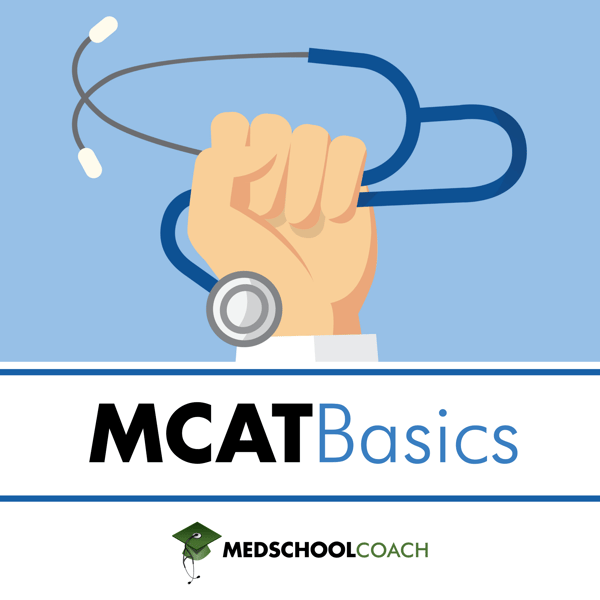DNA Mutations and Repair
MCAT Basics (from MedSchoolCoach)
MedSchoolCoach
4.6 • 612 Ratings
🗓️ 3 June 2025
⏱️ 53 minutes
🧾️ Download transcript
Summary
In this episode, we focus on DNA mutations and repair, a key topic for the Bio/Biochem section of the MCAT. We'll cover the different types of mutations, including point mutations, insertions, and deletions, and explain how they occur due to replication errors or environmental factors like UV radiation.
You'll also learn about the repair mechanisms that fix these genetic changes, such as direct reversal, mismatch repair, and base excision repair. We’ll also discuss how double-strand breaks are addressed through homologous recombination and non-homologous end joining.
By the end of this episode, you'll gain a thorough understanding of how mutations happen and the processes the body uses to repair them, helping you prepare for related MCAT questions.
Visit MedSchoolCoach.com for more help with the MCAT.
Jump into the conversation:
(00:00) Intro
(01:07) Overview of DNA Mutations and Repair
(01:45) What is a Mutation?
(02:30) Mutations During DNA Replication
(03:29) DNA Polymerase Slippage: Causes duplication of repeated sequences in DNA
(06:15) Mutations Before or After Replication: Caused by mutagens like radiation or chemicals
(07:19) Mutagens vs. Carcinogens: Differences between agents that cause mutations and those that cause cancer
(09:56) Types of Mutations: Overview of point mutations, insertions, and deletions
(12:00) Frameshift Mutations: How insertions or deletions shift the reading frame
(29:50) Chromosomal Mutations: Inversions and translocations
(35:35) DNA Repair Mechanisms: Introduction to replication repair, mutation repair, and break repair
(36:51) Proofreading by DNA Polymerase: Repairing replication errors
(39:20) Direct Reversal DNA Repair: Enzymes directly fix damaged DNA
(40:41) Mismatch Repair: Fixing base mismatches and insertion-deletion loops
(43:25) Base Excision Repair: Correcting single-base mutations
(46:03) Nucleotide Excision Repair: Fixing bulky DNA damage like pyrimidine dimers
(47:56) Interstrand Cross-Link Repair: Repairing DNA strands covalently cross-linked together
(50:27) Single-Strand Break Repair: Ligating broken DNA strands back together
(51:16) Double-Strand Break Repair: Homologous recombination and non-homologous end joining
(54:13) Summary of DNA repair mechanisms
Transcript
Click on a timestamp to play from that location
| 0:00.0 | Welcome to MCAT Basics, your ultimate guide to the essential topics you need to master for the MCAT, |
| 0:07.0 | brought to you by the physicians at Med School Coach. |
| 0:10.0 | Every week, Sam Smith breaks down high-yield MCAT topics, ensuring you're primed for success on test day. |
| 0:17.0 | Join Sam as we explore the most crucial subjects outlined by the AAMC, pulled from official |
| 0:22.1 | practice materials and third-party resources. Get ready to elevate your MCAT game with topics |
| 0:27.1 | tailored to maximize your score potential. Hello, I'm Sam Smith. This podcast covers DNA mutations |
| 0:34.5 | and DNA repair. I'll first talk about what causes DNA mutations and what |
| 0:39.2 | types of mutations can occur. Then I'll get into how these mutations are repaired. And I'll |
| 0:44.4 | talk about how mutations can either be repaired during replication or after replication. And this material |
| 0:50.9 | is going to show up in one out of the four sections. This is the bio-biochem section. |
| 0:56.4 | With that said, I'm going to jump into it, and I hope this podcast is helpful in your studies. |
| 1:01.9 | Also, I should say thanks to the listener, Melinda, for recommending this topic. |
| 1:17.6 | All right, so the first thing I want to cover here is just the general concept of what a mutation is. |
| 1:19.9 | So a mutation is an error in the DNA sequence encoding a protein. |
| 1:24.6 | So for example, let's say that part of the sequence of a small protein is A-A-G-G-G-T-T. |
| 1:31.2 | If part of the sequence were to become mutated, that could mean that it was just really damaged, |
| 1:36.1 | or it could mean that the actual genetic sequence was changed. Maybe now it becomes |
| 1:40.7 | A-A-G-G-G-A. That's pretty simple, and I'm sure you have a relatively good understanding of what a mutation is, |
| 1:49.2 | but what causes these mutations? |
| 1:51.8 | Well, there are many, many, many, many different things that can cause DNA mutations. |
| 1:56.0 | And I'm going to break these down into two categories. |
| 1:58.6 | Number one, mutations that occur during DNA replication, and number two, mutations |
... |
Please login to see the full transcript.
Disclaimer: The podcast and artwork embedded on this page are from MedSchoolCoach, and are the property of its owner and not affiliated with or endorsed by Tapesearch.
Generated transcripts are the property of MedSchoolCoach and are distributed freely under the Fair Use doctrine. Transcripts generated by Tapesearch are not guaranteed to be accurate.
Copyright © Tapesearch 2025.

